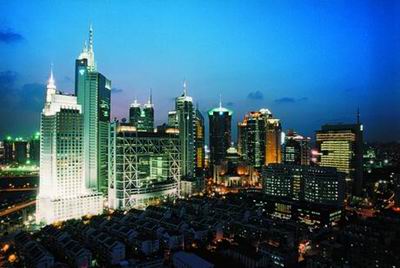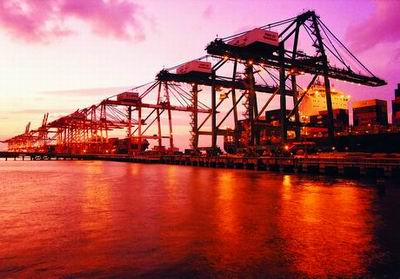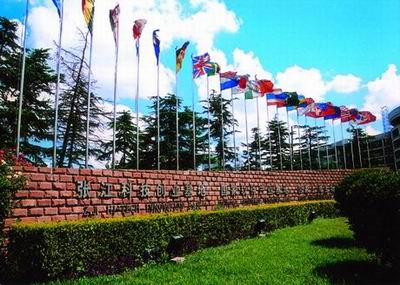Pudong Today
The Pudong New Area, with a size of 522.75
square kilometers and a population of 1.7667 million by the end of 2003, is a
triangular area to the east of the Huangpu
River and to the
west of the Yangtze
River estuary. It occupies the central spot
of China's
coastal line where the Yangtze
River pours into the East China Sea. With the
developed downtown Shanghai and the vast and rich Yangtze River Delta in its
west precincts, the new area has an easy access to economically-developed
countries and regions on the Pacific Rim and in Southeast Asia. The development
of Pudong started in early 1990s. After more than 10 years, the great efforts in
opening up and development have paid off. Today, it's a bright pearl on the
mouth of the Yangtze
River.
Economic Development
Since the introduction of
its opening policy in 1990, Pudong has been playing an exemplary and
spearheading role in creating new systems, industrial upgrading and opening door
wider to the outside world. It¡¯s GDP growth rate surpassed the city¡¯s average
for 13 consecutive years. In 1990, Pudong's economic output value was only 6.024
billion yuan, but the figure soared to more than 100 billion yuan in 2001 and
150.388 billion yuan in 2003, up 9.1 times and representing an annual increase
of 19.5% in terms of comparable prices. In 2003, of the total added value of the
district, its secondary industry reached 79.869 billion yuan, up 20% from the
previous year and the figures with its tertiary industry stood at 69.84 billion
yuan and 14.9%, respectively.
Main Indexes of Economic Development in Pudong
District
(100 million yuan)
Year
Added Value
Total Industrial Output Value Retail Sales Fixed Asset
Investment
1990
60.24
176.85
14.28
14.15
1991
71.54
228.90
18.00
28.95
1992
101.49 363.71
28.23
75.00
1993
164.00 604.40
41.92
164.56
1994
291.20 886.35
82.74
261.13
1995
414.65 968.03
110.00 285.07
1996
496.47 1130.42 140.21 395.04
1997
608.22 1349.01 162.23 504.36
1998
704.27 1414.99 178.97 583.22
1999
801.36 1450.81 198.31 438.20
2000
920.52 1625.77 215.17 351.06
2001
1082.36
1888.74
233.02 416.18
2002
1251.16
2190.00
256.20 586.61
2003
1503.88
2855.90
313.24
602.16
Investment Environment
To improve its investment environment,
Pudong has insisted on giving priority to the infrastructure construction. Since
1990, the district has invested a total of 130 billion yuan into urban
construction projects. The district had completed a number of major projects,
including the Pudong
International Airport, Metro
Line 2, Waigaoqiao Power Plant, the East China Sea Natural Gas project and the
exemplary maglev. By the end of 2003, overseas investors from more than 84
countries and regions had invested in 10,151 projects in the district, involving
contracted investment of 21.996 billion US dollars. Sixty-three foreign-funded
financial institutions had branched into the district. There were a total of
7,933 enterprises registered in the district, with a combined registered capital
of 44.486 billion yuan.
Financial and Trade Zone

Lujiazhui Financial and Trade Zone facing
the Bund across the Huangpu River is the city's largest central business
district. By the end of 2003, a total of 143 Chinese and foreign financial
institutions had started operation in this zone. And the transaction volumes a
number of key markets, including Shanghai Stock Exchange, Shanghai Futures
Exchange, Shanghai Property Rights Exchange, and Shanghai Real Estate Trade
Center have kept growing. A number of world multinational corporations, such as
Siemens, Alcatel, Tomson and Worldbest have relocated their regional
headquarters to the district and some of
China's
largest corporations have also moved their headquarters to Lujiazhui. By the end
of 2003, there were 1,036 skyscrapers had been either completed or under
construction in the district, with an occupancy rate of
89.8%.
Free Trade Zone

Waigaoqiao Free Trade Zone is one of the largest bonded areas in
China. The
free trade zone has expanded its business in international trade, export
processing and bonded storage businesses. In 2003, the Waigaoqiao port handled
55.774 million tons of cargo and 6.614 million TEUs of containers, up 42.5% and
42.8%, respectively, from the previous year. In the year, the operational
revenue of the storage firms in the zone totalled 59.59 billion yuan, up 24.4%
from the previous year. Their business reached major areas all across the
country.
Export Processing Zone

Jinqiao Export Processing Zone has become
one of Shanghai's key bases
for development of its high and new technology. By the end of 2003, the zone had
attracted a total of 234 overseas-invested enterprises with a combined
contractual overseas investment of 10.07 billion US dollars, of which 3.05
billion US dollars had already been utilized. In the year, the zone's industrial
output value totalled 103.819 billion yuan, of which the output value of high
and new technology industries reached 50.769 billion yuan, or 48.9% of the
total. Fast development has been reported in high and new technology industries
such as manufacturing of cars and auto parts, microelectronics and computers,
modern telecommunication facilities, biomedicine, integration of optical and
electric machinery and new household electric
appliances.
High-Tech
Park

Zhangjiang High-Tech Park's attraction has become more
salient. By the end of 2003, there were 140 IC firms and 30 verified research
institutions. It also had buildings designated for enterprise incubation, with a
combined floor space of 334,800 square meters and housing 382 firms. Of the
world¡¯s top 10 IC companies, seven had already branched into this zone. The
Pudong software park and the 863 information security projects had played an
important exemplary role. More than 215 enterprises, including the Citibank
Asia-Pacific Software, Sony, BearingPoint and Kyocera, had moved into the
software park.



